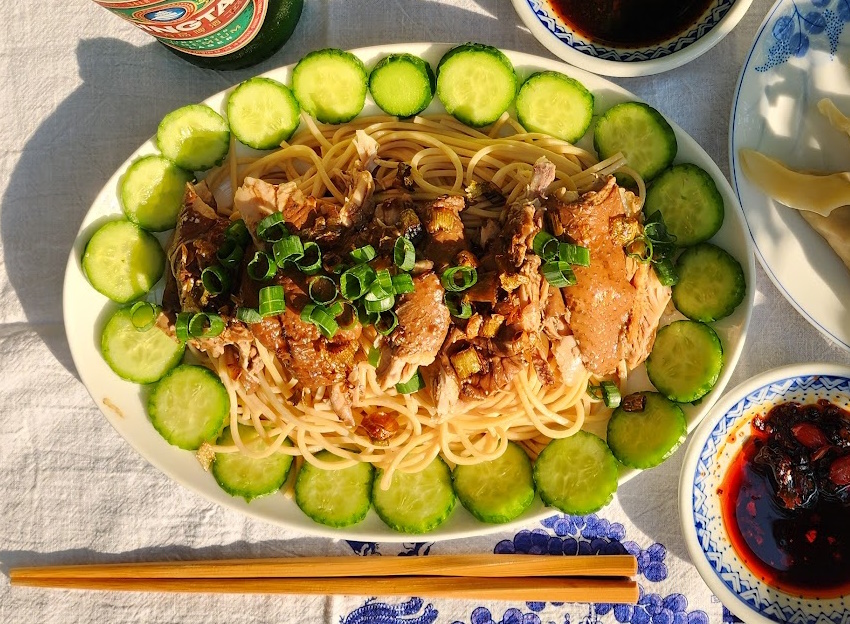Our Recipe of the Month is for Thai Nam Jim Jeaw, a versatile sauce that will bring your grilled fish or meat to a whole new level of scrumptiousness. The secret really is in the sauce.
![]()
Nam Jim Jeaw is a classic Thai dipping sauce that is hailed from the Isan or Northeastern region of Thailand, and it's particularly associated with the cuisine of this region.
The name "Nam Jim Jeaw" essentially translates to "the dipping sauce from the Northeast" in Thai, with "Nam Jim" meaning dipping sauce and "Jeaw" also meaning dipping sauce but in the Northeastern Thai dialect. The majority ethnic group that lives in the Isan area of Thailand is the Isan people. They are also known as Thai Isan, Thai-Lao, Lao Isan, or Isan Lao. They are ethnically Lao and speak a variant of the Lao language when at home (the three main Lao dialects spoken in Northeastern Thailand are summarized as the Isan language).
The Isan people make up approximately 80% of the population in the Isan region. They are descended from the Lao people who migrated to the region over centuries, beginning in the 14th century. The Isan people have their own unique culture and identity, which is distinct from both the Lao people of Laos and the Central Thai people of Thailand.
This sauce is a staple in Thai cuisine, especially when it comes to accompanying meats. It's the go-to dipping sauce for a variety of meats, particularly grilled meats such as grilled chicken, beef, or pork. The essential ingredients of Nam Jim Jeaw include fish sauce, lime juice and/or tamarind, sugar, dried chilies, toasted rice powder, and fresh herbs. The two most unique ingredients in this sauce are toasted, ground rice and toasted chili flakes. These ingredients add a unique texture to the sauce and also add a smoky taste that compliments proteins such as meat and fish. Nam Jim Jeaw uses dried chili flakes as opposed to fresh chilies like many other Thai dishes. This is intentional and proper. The toasted chilies are used to add a slight "bite" to the sauce; this is not a super-hot sauce. The sauce is a balanced blend of spicy, savory, salty, sweet, and sour flavors.
Nam Jim Jeaw is more than just a dipping sauce; it is an important part of Thai culture. It is a symbol of Thai hospitality and generosity. When guests are invited to a Thai home, they are often greeted with a plate of fresh vegetables and a bowl of Nam Jim Jeaw. The dipping sauce is a way to show guests that they are welcome and that their hosts are happy to have them.
Nam Jim Jeaw isn't just confined to the Northeastern region but has found its way throughout Thailand. Its popularity can be attributed to its ease of preparation, versatility, and of course, its deliciousness. The sauce is such a staple that it's commonly expected to be served with meats and is a must-have for Thai barbecues. Over time, the sauce has become synonymous with Thai grilled meats and is a testament to the Thai culinary tradition of balancing flavors to enhance the overall dining experience.
It should be noted that this is a dipping sauce and that is how it is traditionally used. Spreading it directly on meat is not typical. In general, Thai people do not eat with chopsticks. The most common eating style is to eat with a spoon in the right hand and a fork in the left. The fork is used to break up and arrange food and then place it on the spoon which then makes its way to the eater's mouth. Therefore, it is most common that meats are cut into smaller bite-sized pieces.
Like palm sugar, tamarind paste can be bought in nearly any Asian grocery store. Light brown (or even white) sugar and adding more lime juice instead of using palm sugar and tamarind is an option if you can't get to an Asian grocery. Tamarind is sold as a ready-to-use paste (don't get the sauce, it's too thin), or you can prepare your own using a "tamarind cake". The paste can be made from the cake by adding equal parts boiling water and tamarind cake (breaking the amount you want off of the cake) to a bowl. Let it sit in the boiled water until the water is cool and then, with your hands or a wooden spoon, break up the tamarind pieces as small as you can. The final step is to push the tamarind through a standard kitchen strainer (note, you can't use a fine strainer). You can use a spoon for pushing the tamarind through, but using your hands is much easier. Scrape the tamarind off the bottom of the strainer and voila! you have tamarind paste!
Thai Nam Jim Jeaw sauce can be used on grilled meats, fish, or even vegetables. We chose cod filets for our recipe, but the choice of protein is up to you!
Ingredients:
- 3 Tablespoons uncooked white sticky rice or regular white rice (toasted rice powder (Khao Khua) is also an option)
- 3 Tablespoon finely chopped palm, light brown, or white sugar
- 2 Tablespoons lime juice
- 2 Tablespoons tamarind paste (store bought or prepared from a tamarind cake)
- 3 Tablespoons Thai Fish Sauce
- 1 Teaspoon toasted chili flakes (toasted and then ground dried chilies works too)
- 3 Tablespoons sliced shallots
- 2 scallions, finely sliced
- 1/2 bunch of finely chopped cilantro (or a combination of cilantro and mint)
Preparation:
- In a dry frying pan, toast the uncooked white rice on medium-high heat until the rice is completely browned. The rice must be stirred frequently, and this step takes some time.
- After the rice is browned, set it aside and toast the chili flakes in the same pan. This will not take a lot of time.
- Grind the toasted rice and chili flakes in a spice grinder. It should be coarsely ground, don't grind it into a powder.(/li>
- If you are making your own tamarind paste from a tamarind cake, follow the notes above.
- If using palm sugar, finely slice and chop so the pieces are small and dissolvable in the sauce.
- Slice the shallots thinly to create rounds of shallots and then quarter the slices. (see photo)
- Finely chop the cilantro and/or mint.
- In a bowl, mix all the ingredients together and let sit for a half hour before using.
กินให้อร่อย (kin hai aroi) - Bon Appétit!
Recipe by: T. Johnston-O'Neill
Photos by. Shari K. Johnston-O'Neill









